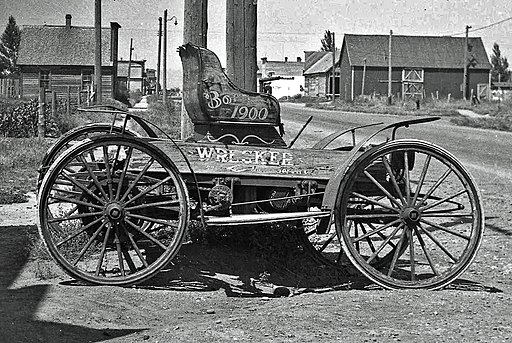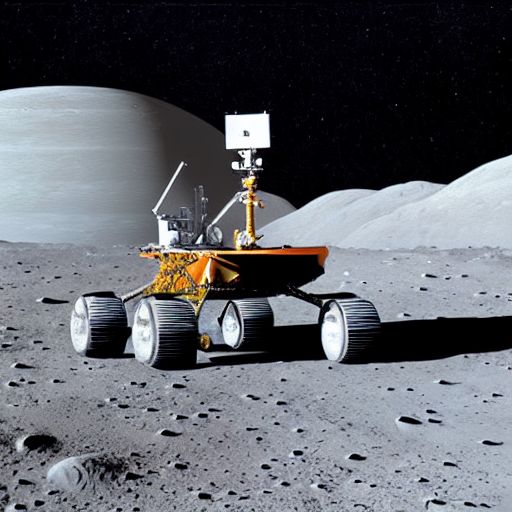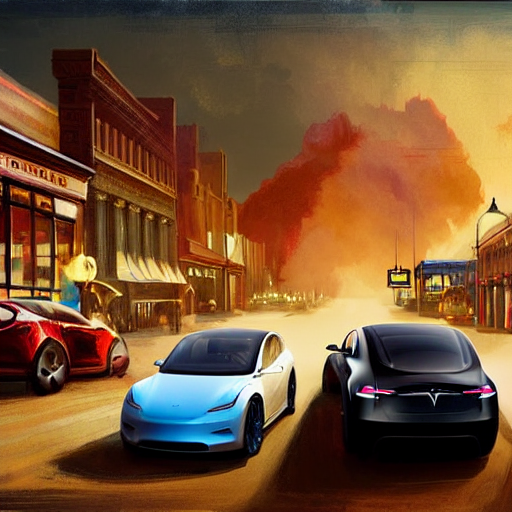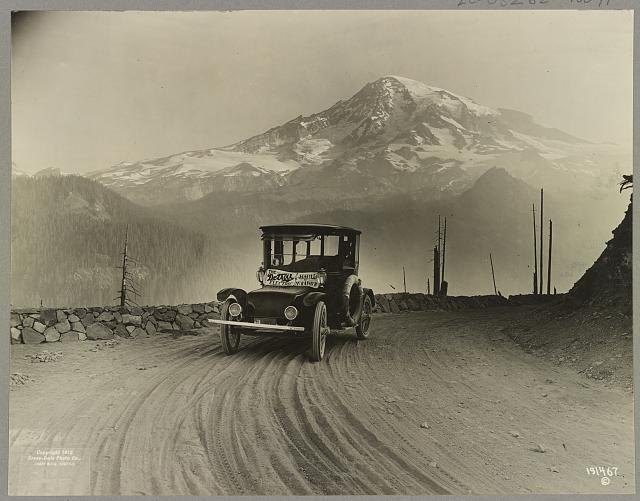Right now electric vehicles are gaining rapidly in popularity, due to the increased pressure of phasing out fossil fuels. They are by no means and new invention though – the history of the electric car is a lot longer and more fascinating than you might think. In fact, it goes back to well before the invention of the internal combustion engine and the famous Benz Patent-Motor Wagen from 1886.
Even Grandma Duck has always been driving an EV whenever she goes to town! To be more precise, a Detroit Electric from 1916.
The history of electric cars is actually a fascinating one, featuring rise, fall and rebirth.
A Brief History of The Electric Vehicle – The Early Years
It is hard to pinpoint exactly when, where and by who the first electric vehicle was invented as it is the result of several different technical breakthroughs – from the development of batteries to the electric motor itself. Several people, all with early electric car projects of their own, where working on the EV concept simultaneously.

That said the first electric cars were most likely developed in the early 19th century in Europe. One of the earliest known electric vehicle was built by Scottish inventor Robert Anderson somewhere around 1832-1839 (the exact date is unknown). Before this there had been horseless carriages powered by steam. All these early cars did indeed look more like a wagon without a horse in front, rather than the design we are used to seeing today.
Anderson’s vehicle however, was powered by non-rechargeable primary cells. These are single-use batteries that produce an electric current when activated by chemical reactions. Once the chemical reactants are depleted, the battery will no longer produce electricity and must be replaced.
The construction consisted of two large wheels connected to a motor, which was enclosed in a housing. The motor was connected to a drive shaft, which distributed power to the wheels. This allowed the carriage to move without the need for a horse. Anderson’s electric carriage also featured an early form of a steering wheel and brakes, allowing the driver to control the vehicle.
The car could travel at a speed of about 12 km/h and was quite cumbersome to steer. The drive unit however, is said to have been impressively quiet even by today’s standards and probably wowed the crowd at the industry exhibition he presented the car at in 1835.
The invention of the rechargeable battery by French physicist Gaston Planté in 1859, was a major breakthrough for electric vehicles as it allowed them to be powered by an easily recharged power source.
In 1884, Thomas Parker built the first production electric car in London and soon after, a number of makers began producing the first practical electric vehicles during the turn of the 20th century.
The Interest In Electric Vehicles Begins To Soar
The modern era of electric vehicles began with the invention of the first practical battery-powered automobile by American inventor William Morrison in 1890. This vehicle had a top speed of 14 miles per hour (22 km/h) and a range of up to 30 miles (48 km). In Austria 1897, a certain Ferdinand Porsche helped designed and build a vehicle which he called the “P1”. Its real name was actually the Egger-Lohner C.2 Phaeton, powered by an octagonal electric motor. It was the world’s first hybrid electric car.
The interest in motor vehicles in general experienced a golden age in the late 1890s and by the early 1900s, electric cars were becoming increasingly popular and by 1905, a significant portion of the cars on the road in the United States were powered by electricity. Between 1896 and 1930 vehicle sales soared and there where close to 1800 different electric car manufacturers just in the US. Including automakers like Woods Motor Vehicle Company, Baker Electric, Anderson Electric Car Company, Columbia Automobile Company, Detroit Electric and Riker Electric Motor Vehicle Co.
Detroit Electric being one of the giants of the era with over 13 000 vehicles produced.
Enter The Combustion Cars
However, this was not to last. Electric cars started experiencing a decline in popularity in the 1920s with the introduction of the internal combustion engine. This development was a game-changer in the automotive industry due to a combination of several factors.
Firstly, the improved road infrastructure of the 1920s enabled people to travel greater distances more quickly, creating a need for more powerful and longer-range vehicles, which gasoline cars could provide. Secondly, the discovery of vast petroleum reserves made gasoline more readily available and cheaper to operate than electric cars, which could only travel at low speeds and had a limited range. Finally, the development of the internal combustion engine meant that gasoline-powered cars could travel both farther and a lot faster than their electric counterparts.
All of these factors combined meant gasoline-powered cars became the more attractive option for consumers. A situation that has been going on essentially until the current date.
A Somewhat Lacklustre Middle Act
Between the golden era of the early 1900s and today, the electric car has attempted several comebacks, but until now they where not particularly successful commercially. The work and research done has nevertheless helped pave the way for the rapid development we see right now.

In the 1960s and 1970s, world political events helped spark interest in electric vehicles once again. This was spurred by increased oil prices and gas shortages due to the Arab Oil Embargo, as well as the passing of the Electric and Hybrid Vehicle Research, Development, and Demonstration Act of 1976. Automakers began exploring options for alternative fuel vehicles, and even NASA helped raise their profile with its electric Lunar rover.
Despite this, the electric vehicles of this era suffered from many drawbacks compared to gasoline-powered cars. For instance they typically had a maximum speed of 45 miles per hour and a range of 40 miles. This did of course not help as far as boosting popularity went.
Spurred by the 1990 Clean Air Act Amendment, the 1992 Energy Policy Act, and the California Air Resources Board’s new transportation emissions regulations, automakers started showing interest in EVs once again during the 90s. One of the most well-known electric cars of this time was the GM EV1, which could reach 0-50 miles per hour in just seven seconds and had a range of 80 miles. Sadly, the EV1 was never commercially viable due to high production costs, and GM discontinued it in 2001. Despite the lack of public attention, scientists and engineers supported by the Energy Department were diligently innovating electric vehicle technology, including batteries, which laid the groundwork for the further development of electric vehicles today.
A New Beginning for Electric Cars
In the 21st century, the industry has seen a huge surge in development with renewed interest in electric vehicles, not least due to the increased concerns for reducing pollution and fighting climate change. Modern society has taken upon itself to try and phase out fossil fuels once and for all in record time. New petrol and diesel cars are about to drive into the sunset in the near future.
Starting with the launch of the Toyota Prius in the mid-1990s, the confidence in electric transport for motorways and longer distances started to build a solid momentum. Then, around 2010, the Chevy Volt and Nissan LEAF hit the road, both becoming hugely successful. This was followed by Tesla Motors, which reshaped the entire electric vehicle industry as we know it. The latest major steps in technological development have been in electric car batteries, with the new technology reducing cost of these units by more than half, while improving performance at the same time. This has enabled the exploitation of the huge potential of electric vehicles, with a broad range of electric cars to choose from.

Today, the new electric vehicle industry is continuing to develop at a rapid pace. Major car companies are embracing the technology, with many launching their own EV models, and governments are providing incentives to speed up the adoption of electric vehicles even further. This is resulting in a huge increase in the number of electric vehicles on the roads worldwide, with a reported 9% global market share of vehicles sold in 2021.
With the new technology continuing to advance, and the cost of electric vehicles decreasing, it is only a matter of time before electric vehicles become the norm.
What the future of electric cars is going to be however, is still an open question. Despite many technological advances there are still many issues to resolve and what type of electric vehicle will become the norm is yet to be determined. This is something discussed at length in the following article.
Featured image source: American Library of Congress.

Author bio:
Mikael is a snowboarder (not professional), a computer game enthusiast, and a decent writer when he puts his mind to it. He’s a self-professed nerd who loves the outdoors and exploring the world of technology. He is the webmaster and editor for Ask Us 1st.

